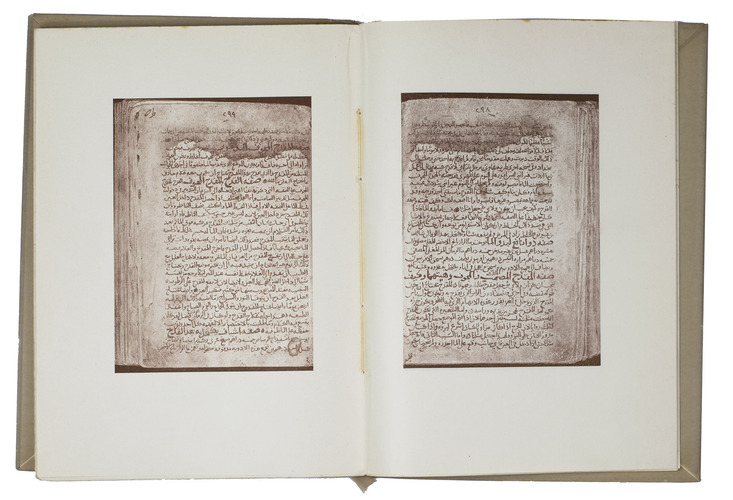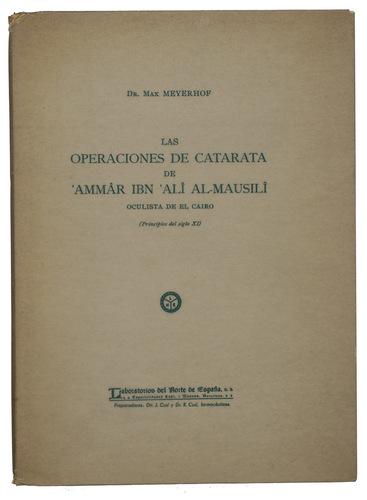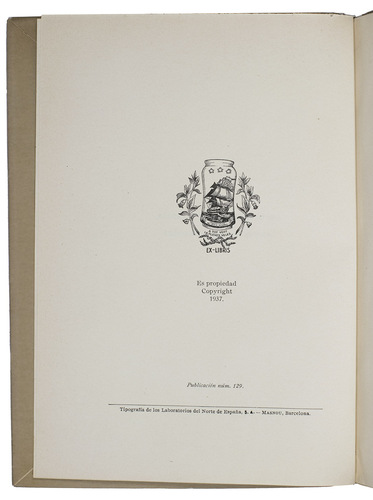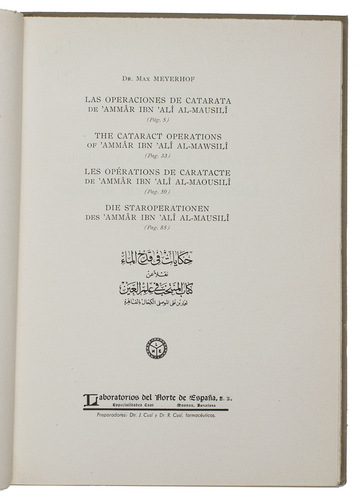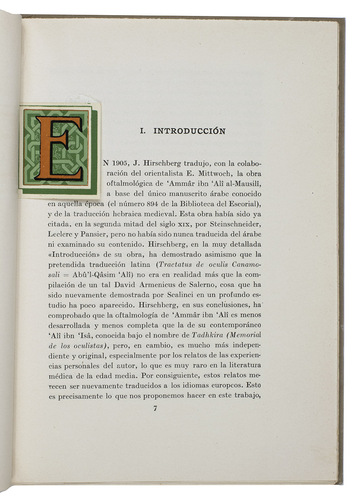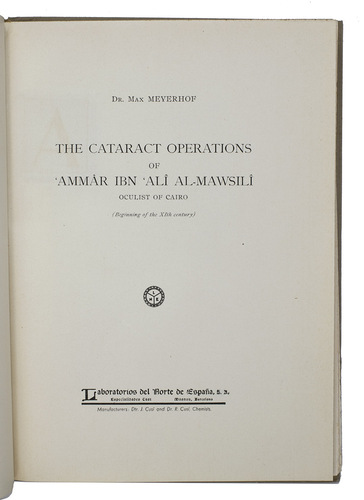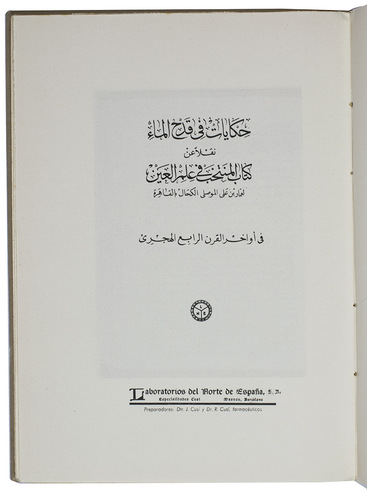'AMMAR IBN 'ALI AL-MAWSILI (Max MEYERHOF, translator).
Las operaciones de catarata de 'Ammâr ibn 'Alî al-Mausilî. [= The cataract operations of ... = Les opérations de cataracte de ... = Die Staroperationen des ...]
El Masnou (Barcelona province), Laboratorios del Norte de España, 1937. Large 8vo. With the text printed in Spanish, English, French and German, each with its own title-page and each with some passages in Arabic (set in Arabic type). With 6 photographs of the original Arabic manuscript bound at the end of the book. The main text for each language opens with a coloured decorated initial, mounted on the first page. With the device of the Laboratorios del Norte de España at the end. Original publisher's printed wrappers. [2 blank], 110, [2 blank], [16], [2 blank] pp.
€ 2,500
First multilingual edition of a landmark in ophthalmology, written in Arabic by the important and well-known 11th-century Arabic oculist and ophthalmologist ʿAmmâr ibn ʿAlî al-Mawṣilî (d. ca. 1010 CE?) and here published in Spanish, English, French and German translations. While staying in Egypt during the reign of al-Hâkim, he wrote his extensive and only known work, Kitâb al-muntakhab fî ʿilm al-ʿayn wa-ʿilalihâ wa-mudâwâtihâ bi-l-adwiyah wa-l-ḥadîd, devoted to the eye and ocular ailments. 'Ammâr al-Mawṣilî is best known as one of the first to extract cataracts using suction, by inventing a syringe hypodermic needle. The present work describes an 11th-century cataract operation, an extraordinary achievement given the state of surgical instruments, antiseptics, anaesthesia and knowledge of ocular physiology. Although treatments for cataracts were known in antiquity, mostly by "couching" (displacing) and in rare instances by removing the clouded lens, but they frequently resulted in total blindness or even death. 'Ammâr al-Mawṣilîs remarkably advanced methods, though no doubt traumatic, must have brough highly important relief to many, since cataracts were a major cause of blindness in his day. European ophthalmic surgeons still relied on couching in the late 1500s and Jacques Daviel presented the pioneering Western treatise on the surgical removal of cataracts only in 1752. The major advances on the present 11th-century techniques came only after the present edition appeared in 1937, with the implantation of artificial lenses after World War II and advances that allowed minimally invasive surgery in the late 1960s.
The present edition contains 'Ammâr al-Mawṣilî's chapter on cataract operations from Kitâb al-muntakhab fî ʿilm al-ʿayn wa-ʿilalihâ wa-mudâwâtihâ bi-l-adwiyah wa-l-ḥadîd. Max Meyerhof (1847-1945) translated the Arabic text into four languages, all present here in a critical edition with some notes by Meyerhof himself. Meyerhof was a German ophthalmologist and medical historian, who practiced in Egypt.
Numbered copy (no. 129), untrimmed and with all bolts unopened, with the printed bookplate of Joaquim Cusí (1879-1968), with his motto, on the verso of the Spanish half-title. Cusí was a Catalan apothecary and mayor of Masnou between 1930 and 1931, known for developing an ophthalmic ointment using yellow mercuric oxide. The Cusí family business would specialize in medicines used in ophthalmology. Wrappers slightly worn (especially around the spine), very slightly browned, and partly separated from the book block at the front and back hinge. Further with only a few spots and some stains on the blanks and a vertical crease in pp. 71-72 and 103-104. Overall in very good condition. WorldCat 5438337, 65030655, 14746816, 892256878, 1044556889, etc.
Related Subjects:







